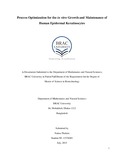Process optimization for the in vitro growth and maintenance of human epidermal keratinocytes
Abstract
In the past few decades, the in vitro cultivation of human epidermal keratinocytes has significantly been improved owing to several developments in terms of media, growth factors and overall culture conditions. This improvement has exhibited great applicability in the treatment of burn and ulcer patients as allografts and autografts, along with contributing in pharmacological tests, skin disorder study, and most recently, in induced pluripotent stem cell (iPSC) technology. However, human cell culture has not yet been advanced enough in Bangladesh, which urges extensive research here. The present study was therefore, aimed to establish an optimum culture condition for human epidermal keratinocytes (HEK). For this purpose, cell dissociation culture of HEK was comparatively analyzed with explant culture and the effects of substrate, donor age, serum concentration and growth factors on keratinocyte culture were evaluated. For cell dissociation culture, epidermal layer from human foreskin after circumcision was separated through cold trypsinization, which yielded 2.5×106 cells on an average from each foreskin with cell viability up to 90%. Compared to tissue culture plastic flasks and medium-conditioned flasks, gelatin-coated plate showed highest number of cell attachment (35-50%). The proliferation rate of keratinocytes from skin of newborn and infant (<3 years old) was found greater than that of middle childhood and teenaged donors (3-15 years old). Serum concentrations of 10-15% yielded 2-4 fold more cell proliferation than lower or higher levels. Additional insulin supplementation at 5 μg/ml gave better cell growth than serum (10%) or hydrocortisone supplement (0.4 μg/ml) alone. However, the most significant cell growth was obtained in serum containing medium supplemented with both insulin (5 μg/ml) and hydrocortisone (0.4 μg/ml). In context of cell growth, plating efficiency and development of confluent culture, cell dissociation method was found superior than that of explant culture. These findings will be helpful to the progress of optimizing human keratinocyte culture that may contribute in future application to diminish the pain of burn patients as well and can further help working with cell biology in our country.

